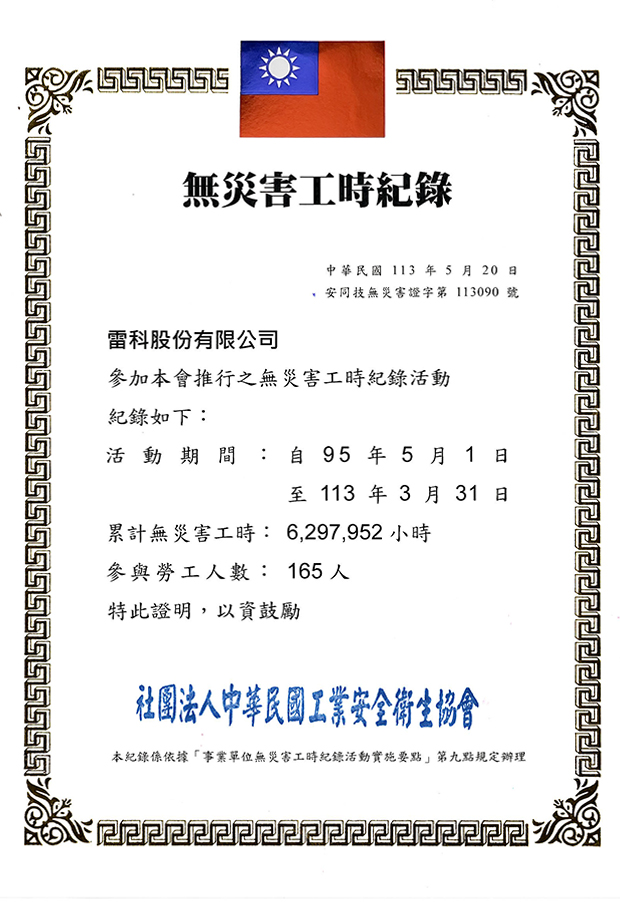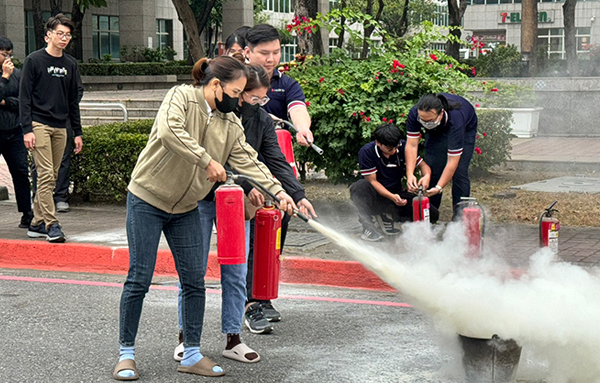持續創新改善 全員追求卓越
Continuous innovation and improvement
All employees pursue excellence
Occupational Safety and Health
Prevent occupational accidents to mitigate risks and hazards to workers.
Occupational Safety and Health Management
In order to safeguard the health and safety of employees, prevent occupational accidents, and achieve the goal of ′zero accidents, zero incidents, ′ Lasertek has established the ′Occupational Safety and Health Work Code′ and the ′Occupational Safety and Health Management Plan′ in accordance with the ′Occupational Safety and Health Act′ and relevant regulations. Furthermore, an Occupational Safety and Health Committee has been formed, requiring each department to set up occupational safety and health units, appoint management personnel and first aid staff, and regularly review local laws to ensure that internal management methods and systems comply with local regulations.
Through periodic occupational hazard identification and risk assessments, Lasertek reviews whether any prohibited substances, as committed by the company, are being used or stored. Additionally, risk evaluations and audits are conducted for the storage and documentation of items like organic solvents, ensuring a safe working environment.
Each year, safety and health education and training are conducted to enable employees to acquire the necessary safety knowledge for their work and improve their emergency response capabilities. Lasertek also participates in the zero-accident activity promoted by the Industrial Safety and Health Association (ISHA) Of the R.O.C, and from May 1, 2006, to March 31, 2024, the company has accumulated a total of 6,297,952 hours of zero-accident work, with 165 workers involved.

| Occupational Safety and Health Management Measures | |
|---|---|
| Item | Description |
| Personal Protective Equipment | For high-risk operating environments in manufacturing that may involve dust and noise, relevant protective equipment such as masks, earplugs, and back braces are provided. |
| Employee Health Checkups | The company arranges health checkups for all employees every two years. For onsite operators, annual special health examinations for noise and n-hexane exposure are provided. Based on the health reports, factory nurses manage health classification and conduct follow-up monitoring. |
| Workplace Environmental Monitoring | Environmental monitoring is conducted semi-annually, covering items such as carbon dioxide levels, noise, and n-hexane, to ensure concentrations and values do not exceed normal levels. |
| Building Public Safety Inspections | Every two years, building public safety inspections are carried out to ensure clear fire evacuation routes and equipment safety, prolonging evacuation time during disasters and reducing the scope and severity of hazards. Additionally, personnel conduct monthly inspections of the facility to ensure that fire safety and evacuation equipment remain unobstructed and functional. |
| Fire Safety Inspections | To ensure that fire safety equipment functions properly in case of fire and to minimize disaster impact, the company conducts annual inspections in coordination with relevant authorities before year-end. |
| Organic Solvent Management | When the procurement department purchases relevant materials, they notify the responsible management personnel for an inventory check and centralized control of the materials. |
| First Aid Personnel Deployment | Each facility has at least one person certified in first aid to ensure that in cases of illness or accidental injury, even those that may be life-threatening, aid is provided to reduce pain and lower the risk of life-threatening harm before medical personnel arrive or the injured are transported to a hospital. |
| Fire Safety Education and Disaster Emergency Response | Regular fire safety education training is held annually to ensure all employees receive basic training in the use of fire extinguishers and fire hoses. Additionally, disaster emergency response drills are conducted annually, tailored to each facility, to practice evacuation and rescue procedures. This helps all employees understand their roles and how to respond during a disaster, minimizing injuries and impacts while enhancing evacuation and rescue capabilities. |
| Safety and Health Education and Training | ||
|---|---|---|
| Course Name (2024) |
Number of Trainees (Participants) |
Training Hours (Man-Hours) |
| Labor Safety and Health Training for New Employees | 33 | 132 |
| Fire Safety Education and Training | 16 | 48 |
| Disaster Emergency Response | 221 | 663 |
| Forklift Operator On-the-Job Training (External) | 3 | 9 |
| First Aid Personnel Professional Training (External) | 6 | 18 |
| Occupational Safety and Health Manager On-the-Job Education (External) | 3 | 15 |
New Employee Fire Drill






Emergency Evacuation Fire Drill






| Occupational Injuries and Occupational Diseases for Employees | |||
|---|---|---|---|
| Item Description | 2022 | 2023 | 2024 |
| Number of Employees | 188 | 192 | 194 |
| Total Working Hours | 376,000 | 380,928 | 388,000 |
| Number of Recordable Occupational Injuries | 2 | 2 | 1 |
| Recordable Occupational Injury Rate (TRIFR) | 1.06 | 1.05 | 0.52 |
| Number of Serious Occupational Injuries | 0 | 0 | 0 |
| Serious Occupational Injury Rate | 0 | 0 | 0 |
| Number of Fatal Occupational Injuries | 0 | 0 | 0 |
| Fatal Occupational Injury Rate | 0 | 0 | 0 |
| Total Number of Disability Injuries | 1 | 0 | 1 |
| Disability Injury Frequency (FR) | 2.65 | 0 | 2.57 |
| Number of Lost Days Due to Disability Injuries | 4 | 0 | 1 |
| Disability Injury Severity Rate (SR) | 10 | 0 | 2 |
| Comprehensive Disability Injury Index (FSI) | 0.16 | 0 | 0.07 |
| Lost Days Rate (LDR) | 2.12 | 0 | 0.51 |
| Types of Occupational Injuries | Cuts | Finger bruises from handling heavy objects, fall from improper forklift operation | Laceration of the left little finger while operating machinery |
| Number of Recordable Occupational Diseases | 0 | 0 | 0 |
| Number of Fatalities Due to Occupational Diseases | 0 | 0 | 0 |
| Fatal Occupational Disease Rate | 0 | 0 | 0 |
| Occupational Disease Occurrence Rate (ODR) | 0 | 0 | 0 |
| Types of Occupational Diseases | None | None | None |
| Table Notes |
|
||
Occupational Health Services
To help employees maintain a balance between work, health, and life, Lasertek provides on-site consultations with doctors and nurses, as well as a health check-up every two years. Follow-up care is conducted by on-site medical staff, ensuring continuous attention to the physical and mental well-being of employees. Each year, based on the results of workplace environment monitoring, Lasertek arranges special health checks for employees exposed to specific health hazards, and implements graded health management as required by law. Employees under Tier 3 health management will have their health status monitored in the following year, while those in Tier 4 are required to attend consultations and receive guidance from on-site medical staff. These staff also conduct workplace inspections and follow-up on recommendations provided by visiting physicians.
In 2024, a total of 70 employees underwent special health hazard check-ups. Among them, 3 were classified as Tier 4 health management, and their health status is regularly monitored by the on-site nurse.
For health promotion training courses, we first survey employees’ preferences on the topics before planning the sessions. Through these courses, we aim to improve employees’ health knowledge and enhance both their physical and mental well-being.
Lasertek is committed to creating a healthy workplace. In 2018, we received the ′Badge of Accredited Healthy Workplace – Smokefree & health promotion′ from the Health Promotion Administration, Ministry of Health and Welfare. Additionally, in 2020 and 2023, we were awarded the ′Badge of Accredited Healthy Workplace - Health Promotion Seal.′ Lasertek will continue to care for the physical and mental health of every employee, fostering a safe and supportive working environment.
| Laser tek Health Care Items | |
|---|---|
| Category | Details |
| Health Care | Through regular health check-ups every two years, followed by ongoing care from on-site doctors and nurses, we continuously monitor and support employees’ physical and mental health. In 2024, a total of 100 health guidance sessions were provided. |
| Health Promotion | Health promotion courses are organized to provide health-related information, improve existing lifestyle habits, and enhance physical and mental well-being. In 2024, a total of 3 courses were held, with 67 participants and a total of 6 course hours. |
| Self-Monitoring | To safeguard employee health, blood pressure monitors are available at all factory locations for self-use. The recorded data is uploaded for on-site nurses to track. This encourages high-risk employees, especially those with cardiovascular concerns, to develop regular monitoring habits, enabling follow-up care and guidance from the nurses. |
| Musculoskeletal Disorders | Every two years, employees complete questionnaires that are analyzed to identify those at risk. At-risk employees are scheduled for consultations with doctors, and follow-up tracking is handled by the on-site nurses. |
| Abnormal Workload | A biennial survey is conducted among all employees to identify and assess the risks of abnormal workload and categorize the level of risk. |
| Workplace Violence Prevention | Lasertek implements measures to prevent workplace violence. The employee handbook includes a grievance procedure and contact numbers, as well as a statement prohibiting workplace violence and sexual harassment. The internal management policies and work environment are reviewed annually. |
| Maternity Health Protection Program | On-site nurses conduct interviews with pregnant employees to assess risks, evaluate work responsibilities, and provide prenatal and postnatal health education. Additionally, the company actively offers information on available subsidies. In 2024, 3 employees received maternity health tracking and guidance. |
| Lasertek Employee Health Check-Up System | ||
|---|---|---|
| New Employee Health Check | Regular Health Check | Specialized Health Check |
| New employees are required to submit their hospital health examination records upon reporting for duty. These records are then provided to the on-site medical staff for follow-up care. | To ensure employee health, the company conducts a health check-up every two years. The results are reviewed by the on-site doctors and nurses, who follow up as necessary. Additionally, health promotion courses or activities are organized. | Lasertek conducts annual specialized health check-ups for operational staff, focusing on two specific tasks: noise and n-hexane exposure. The on-site nurses classify employees' health based on the reports and provide ongoing follow-up care. |
Lasertek fully ensures the rights of employees to take parental leave. Employees who have worked for more than six months may apply for unpaid parental leave for up to two years before each child reaches the age of three, with the leave period ending when the child turns three. During the unpaid parental leave, employees can continue to participate in the company’s social insurance program. We actively implement the spirit of the Gender Equality in Employment Act and advocate for SDG5 ′Gender Equality′ from the Sustainable Development Goals (SDGs). In line with Article 31 of the Occupational Safety and Health Act, Lasertek has also established mechanisms for maternity health protection to ensure the physical and mental health of pregnant, postpartum, and breastfeeding employees. In 2024, 3 employees received maternity health follow-up and guidance from our on-site healthcare team. Additionally, the company has set up nursing rooms to provide a safe and convenient space for employees to use when needed.
| Lasertek 2023 Parental Leave Statistics | |||
|---|---|---|---|
| Description | Male | Female | Total |
| 2024 Number of employees eligible for parental leave (a) | 5 | 6 | 11 |
| 2024 Actual Number of Parental Leave Applicants (b) | 1 | 2 | 3 |
| 2024 Parental Leave Application Rate (b)/(a) | 20% | 33.33% | 27.27% |
| 2024 Expected Number of Parental Leave Returnees (c) | 1 | 0 | 1 |
| 2024 Actual Number of Parental Leave Returnees (d) | 1 | 0 | 1 |
| 2024 Parental Leave Return Rate (d)/(c) | 100% | 0% | 100% |
| 2023 Actual Number of Parental Leave Returnees (e) | 1 | 1 | 2 |
| Number of employees who stayed for one year after returning from parental leave in 2023 (f) | 1 | 1 | 2 |
| 2023 Parental Leave Retention Rate (f)/(e) | 100% | 100% | 100% |
| Note: |
|
||
